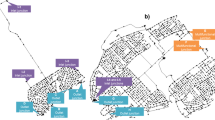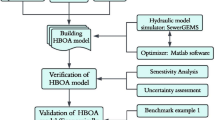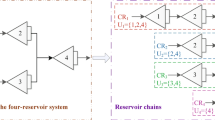Abstract
Data-space inversion (DSI) methods provide posterior (history-matched) predictions for quantities of interest, along with uncertainty quantification, without constructing posterior models. Rather, predictions are generated directly from a large set of prior model simulations and observed data. In this work, we develop a data-space inversion with variable control (DSIVC) procedure that enables forecasting with user-specified well controls in the post-history-match prediction period. In DSIVC, flow simulations on all prior realizations, with randomly sampled well controls, are first performed. User-specified controls are treated as additional observations to be matched in posterior predictions. Posterior data samples are generated using a randomized maximum likelihood procedure with a gradient-based optimizer. For prescribed post-history-match well control settings, posterior predictions can be generated in seconds or minutes. Results are presented for a channelized system, and posterior predictions from DSIVC are compared with those from the standard DSI method. Standard DSI requires prior models to be re-simulated using the specified controls, while DSIVC requires only one set of prior simulations. Substantial uncertainty reduction is achieved through data-space inversion, and reasonable agreement between DSIVC and DSI results is generally observed. DSIVC is then applied for data assimilation combined with production optimization under uncertainty, as well as for closed-loop reservoir management, which entails a sequence of data assimilation and optimization steps. Clear improvement in the objective function is attained in these examples.
Similar content being viewed by others
References
Aitokhuehi, I., Durlofsky, L.J.: Optimizing the performance of smart wells in complex reservoirs using continuously updated geological models. J. Pet. Sci. Eng. 48(3-4), 254–264 (2005)
Audet, C., Dennis, J.E. Jr.: Mesh adaptive direct search algorithms for constrained optimization. SIAM J. Optim. 17(1), 188–217 (2006)
Brouwer, D.R., Jansen, J.D.: Dynamic optimization of waterflooding with smart wells using optimal control theory. SPE J. 9(04), 391–402 (2004)
Chen, C., Gao, G., Li, R., Cao, R., Chen, T., Vink, J.C., Gelderblom, P.: Global-search distributed-Gauss-Newton optimization method and its integration with the randomized-maximum-likelihood method for uncertainty quantification of reservoir performance. SPE Journal 23(05), 1496–1517 (2018)
Emerick, A.A., Reynolds, A.C.: Investigation of the sampling performance of ensemble-based methods with a simple reservoir model. Comput. Geosci. 17(2), 325–350 (2013)
Gao, G., Zafari, M., Reynolds, A.C.: Quantifying uncertainty for the PUNQ-S3 problem in a Bayesian setting with RML and EnKF. Paper SPE-93324-MS, presented at SPE Reservoir Simulation Symposium, The Woodlands, Texas, 31 January-2 Feburary (2005)
Jansen, J.D., Brouwer, D.R., Douma, S.G.: Closed loop reservoir management. Paper SPE-119098-MS, presented at SPE Reservoir Simulation Symposium, The Woodlands, Texas, 2-4 February (2009)
Jansen, J.D., Brouwer, D.R., Nævdal, G., Van Kruijsdijk, C.: Closed-loop reservoir management. First Break 23(1), 43–48 (2005)
Jiang, S.: Data-space inversion with variable well controls in the prediction period. Master’s thesis, Stanford University (2018)
Kostakis, F., Mallison, B., Durlofsky, L.: Multifidelity framework for uncertainty quantification with multiple quantities of interest. In: ECMOR XVI-16th European Conference on the Mathematics of Oil Recovery (2018)
Le Digabel, S.: Algorithm 909: NOMAD: Nonlinear optimization with the MADS algorithm. ACM Trans. Math. Softw. 37(4), 44 (2011)
Lima, M.M., Emerick, A.A., Ortiz, C.E.: Data-space inversion with ensemble smoother. arXiv:1903.09576 (2019)
Oliver, D.S.: Metropolized randomized maximum likelihood for improved sampling from multimodal distributions. SIAM/ASA Journal on Uncertainty Quantification 5(1), 259–277 (2017)
Oliver, D.S., Chen, Y.: Recent progress on reservoir history matching: a review. Comput. Geosci. 15(1), 185–221 (2011)
Oliver, D.S., Reynolds, A.C., Liu, N.: Inverse Theory for Petroleum Reservoir Characterization and History Matching. Cambridge University Press, Cambridge (2008)
Sarma, P., Durlofsky, L.J., Aziz, K., Chen, W.H.: Efficient real-time reservoir management using adjoint-based optimal control and model updating. Comput. Geosci. 10(1), 3–36 (2006)
Satija, A., Caers, J.: Direct forecasting of subsurface flow response from non-linear dynamic data by linear least-squares in canonical functional principal component space. Adv. Water Resour. 77, 69–81 (2015)
Satija, A., Scheidt, C., Li, L., Caers, J.: Direct forecasting of reservoir performance using production data without history matching. Comput. Geosci. 21(2), 315–333 (2017)
Scheidt, C., Renard, P., Caers, J.: Prediction-focused subsurface modeling: investigating the need for accuracy in flow-based inverse modeling. Math. Geosci. 47(2), 173–191 (2015)
Sun, W., Durlofsky, L.J.: A new data-space inversion procedure for efficient uncertainty quantification in subsurface flow problems. Math. Geosci. 49(6), 679–715 (2017)
Sun, W., Durlofsky, L.J.: Data-space approaches for uncertainty quantification of CO2 plume location in geological carbon storage. Adv. Water Resour. 123, 234–255 (2019)
Sun, W., Hui, M.H., Durlofsky, L.J.: Production forecasting and uncertainty quantification for naturally fractured reservoirs using a new data-space inversion procedure. Comput. Geosci. 21(5-6), 1443–1458 (2017)
Tarantola, A.: Inverse Problem Theory and Methods for Model Parameter Estimation. SIAM, Philadelphia (2005)
Trehan, S., Durlofsky, L.J.: Machine-learning-based modeling of coarse-scale error, with application to uncertainty quantification. Comput. Geosci. 22(4), 1093–1113 (2018)
Wang, C., Li, G., Reynolds, A.C.: Production optimization in closed-loop reservoir management. SPE J. 14(03), 506–523 (2009)
Zhou, Y.: Parallel general-purpose reservoir simulation with coupled reservoir models and multisegment wells. Ph.D. thesis, Stanford University (2012)
Funding
The authors received partial funding from Chevron Energy Technology Company and the Stanford Smart Fields Consortium.
Author information
Authors and Affiliations
Corresponding author
Additional information
Publisher’s note
Springer Nature remains neutral with regard to jurisdictional claims in published maps and institutional affiliations.
Rights and permissions
About this article
Cite this article
Jiang, S., Sun, W. & Durlofsky, L.J. A data-space inversion procedure for well control optimization and closed-loop reservoir management. Comput Geosci 24, 361–379 (2020). https://doi.org/10.1007/s10596-019-09853-4
Received:
Accepted:
Published:
Issue Date:
DOI: https://doi.org/10.1007/s10596-019-09853-4




